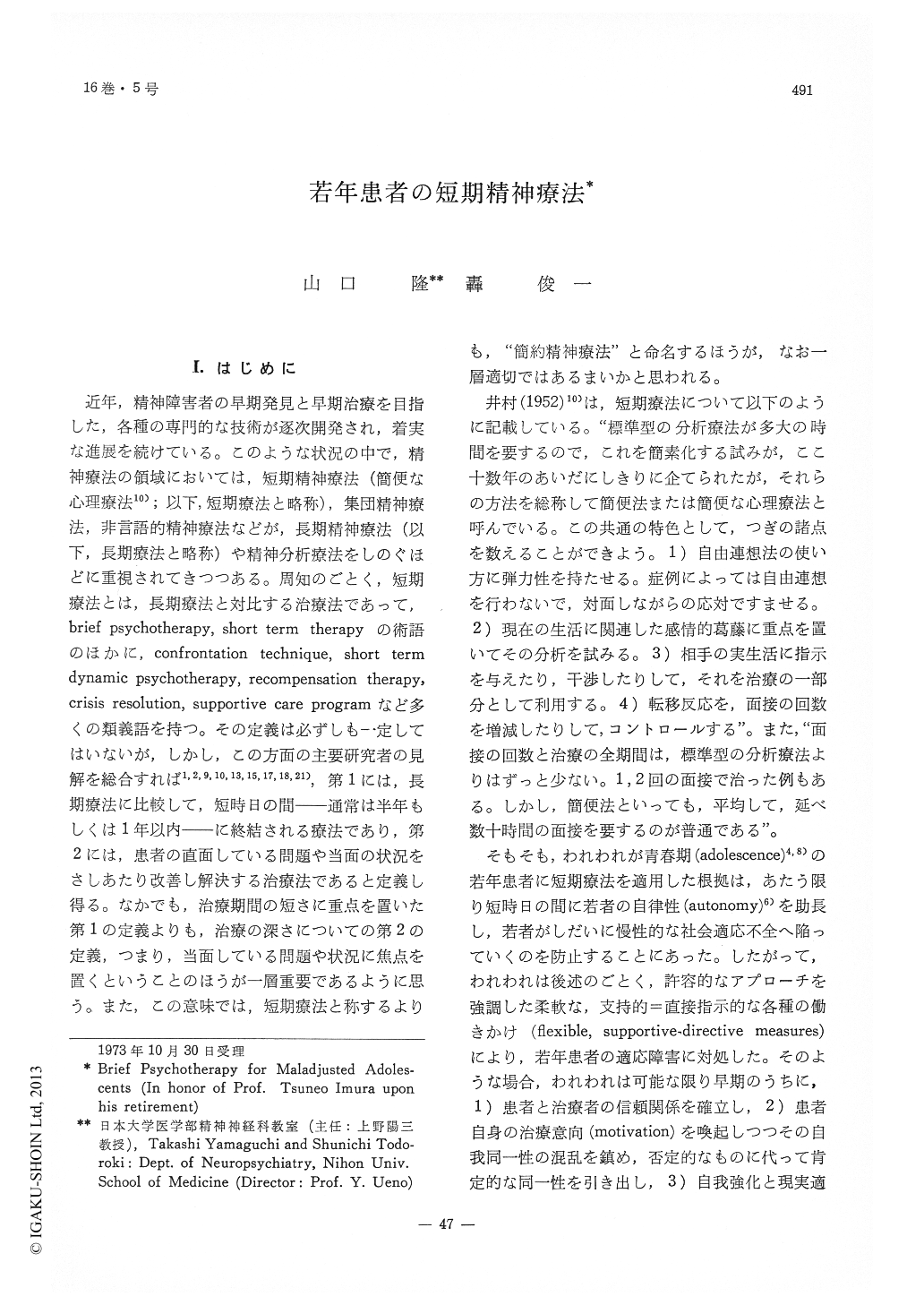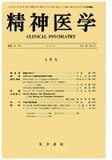Japanese
English
- 有料閲覧
- Abstract 文献概要
- 1ページ目 Look Inside
I.はじめに
近年,精神障害者の早期発見と早期治療を目指した,各種の専門的な技術が逐次開発され,着実な進展を続けている。このような状況の中で,精神療法の領域においては,短期精神療法(簡便な心理療法10);以下,短期療法と略称),集団精神療法,非言語的精神療法などが,長期精神療法(以下,長期療法と略称)や精神分析療法をしのぐほどに重視されてきつつある。周知のごとく,短期療法とは,長期療法と対比する治療法であって,brief psychotherapy,short term therapyの術語のほかに,confrontation technique,short term dynamic psychotherapy,recompensation therapy,crisis resolution,supportive care programなど多くの類義語を持つ。その定義は必ずしも一定してはいないが,しかし,この方面の主要研究者の見解を総合すれば1,2,9,10,13,15,17,18,21),第1には,長期療法に比較して,短時日の間―通常は半年もしくは1年以内―に終結される療法であり,第2には,患者の直面している問題や当面の状況をさしあたり改善し解決する治療法であると定義し得る。なかでも,治療期間の短さに重点を置いた第1の定義よりも,治療の深さについての第2の定義,つまり,当面している問題や状況に焦点を置くということのほうが一層重要であるように思う。また,この意味では,短期療法と称するよりも,"簡約精神療法"と命名するほうが,なお一層適切ではあるまいかと思われる。
井村(1952)10)は,短期療法について以下のように記載している。"標準型の分析療法が多大の時間を要するので,これを簡素化する試みが,ここ十数年のあいだにしきりに企てられたが,それらの方法を総称して簡便法または簡便な心理療法と呼んでいる。この共通の特色として,つぎの諸点を数えることができよう。1)自由連想法の使い方に弾力性を持たせる。症例によっては自由連想を行わないで,対面しながらの応対ですませる。2)現在の生活に関連した感情的葛藤に重点を置いてその分析を試みる。3)相手の実生活に指示を与えたり,干渉したりして,それを治療の一部分として利用する。4)転移反応を,面接の回数を増減したりして,コントロールする"。また,"面接の回数と治療の全期間は,標準型の分析療法よりはずっと少ない。1,2回の面接で治った例もある。しかし,簡便法といっても,平均して,延べ数十時間の面接を要するのが普通である"。
The two adolescents chosen for the case presentations in this paper were cases exhibiting the following common features: 1) Being reared at a developing urban area in a middle class home with a well-educated father. 2) A relatively mature premorbid character, described as "the slightly undeveloped character". 3) A reaction pattern of passive-aggressive "compulsive obsessive behavior" of school refusal, secondary to antagonism against the father on the basis of a long-term over-dependency on the mother in a triangle with slightly or moderately characterologically disturbed parents. 4) Exhibiting "good signs" including what the authors call "strength as a youth", i. e. that the patient enables the therapist to recognize his potentiality or readiness for a quick recovery. 5) Responding positively to the flexible, supportive and directive measures of the permissive brief psychotherapy, which is considered as the treatment of choice for the maladjusted adolescents.
Case 1: A 15 year old female, high school freshman, slightly over-weight, with a mild hysterical character disorder featuring over-identification with the mother, who manifested a passive-aggressive, compulsive obsessive behavior of both school refusal and "binge eating", which lasted for 2 weeks, apparently secondary to a lost love. Her identity confusion was quickly resolved within two brief encounter sessions with her therapist, simultaneously with her over-anxious mother's recompensation.
Case 2: A 17 year old male, high school senior, premorbidally inactive and compulsive, who was referred by the police one month after he began refusing to go to school, who demanded imprisonment for his desire of stealing. His negative identity was finally substituted by a positive one during the course of five brief psychotherapeutic sessions, to which his establishing a good relationship with a father-figure appeared most contributory.
First, focus was on the practical techniques including a particular use of metaphor, simile and/or allusion -the therapist's telling the adolescent patients his ready-made children's stories describingthe patient's present predicament-, applied in brief psychotherapy which placed emphasis on the essential variables for an effective brief psychotherapy, as well as on the indication of and the limitation to brief psychotherapy. It was stressed that of utmost importance for an effective brief psychotherapy with the adolescent is a quickly established complementary empathic communication between the therapist and the patient of the therapist's understanding, empathy, and permissiveness of the adolescent's idiosyncratic psychology and of his imperfect human nature and, in particular, of the "good signs", as described below.
The authors have considered the following variables as "good signs". i. e. indices of readiness for brief psychotherapy with maladjusted adolescents: 1) A relatively mature, "slightly undeveloped" (in contrast to " highly undeveloped") premorbid character. 2) A relatively good premorbid adjustment. 3) Presence of apparent precipitating events. 4) Initial onset, with no previous history of adolescent maladjustment. 5) Acute phase. 6) A localized maladjustment. 7) Sufficient motivation on both the patient and the family's side. 8) "Strength as a youth", i. e. the adolescent's potentiality for a quick recovery, which is easily recognized by the diagnostician during the initial interview.

Copyright © 1974, Igaku-Shoin Ltd. All rights reserved.


